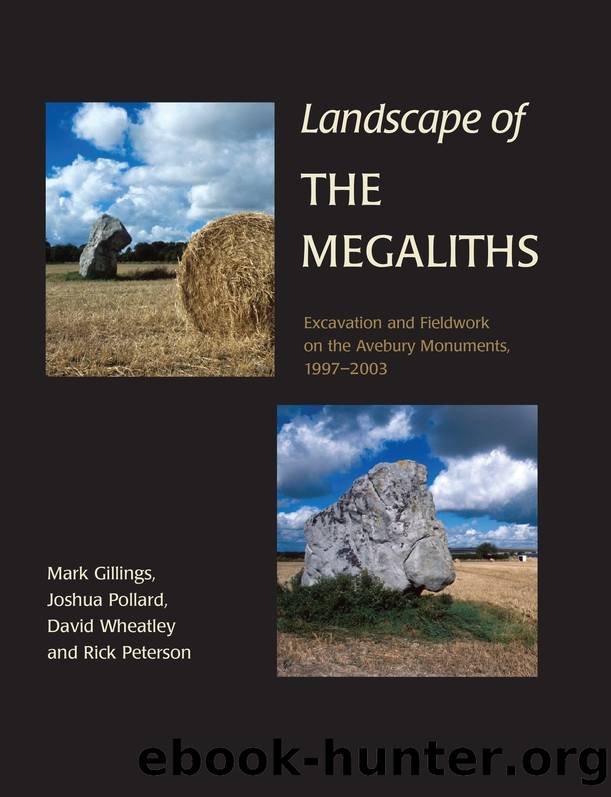Landscape of the Megaliths by Gillings Mark.; & Joshua Pollard & David Wheatley

Author:Gillings, Mark.; & Joshua Pollard & David Wheatley
Language: eng
Format: epub
ISBN: 9781782975236
Publisher: Casemate Publishers & Book Distributors, LLC
Published: 2013-09-26T00:00:00+00:00
Monuments, cosmology, materiality and non-human agency
Our accounts of later Neolithic monumentality have tended to focus on monument construction as responding to, or being implicated in, the formation of social strategies, tensions or goals (Renfrew 1973; Bradley 1984; Barrett 1994). There is no question that such a sociological perspective has been highly productive and illuminating, and has produced some stimulating interpretive accounts of the British Neolithic. However, it is based upon an understanding of power and agency as residing solely in the domain of human practice, and has perhaps ignored the extent to which the creation of monuments and sacred landscapes was a response to the perceived agency of other things, especially that of supernatural beings, the legacy of mythic association and the âspiritsâ of place (Carmichael et al. 1994). The challenge is to find ways of comprehending the conditions under which monuments were created that works together the interplay between such human and non-human agency.
A lead is provided by a recent body of literature that has sought to demonstrate how people and non-human components of the world are embroiled in heterogeneous networks that constitute each other. Various writers in the social sciences have highlighted how non-human things in their broadest sense âincluding material culture, architecture, fauna, flora and landscape featuresâare, like people, delegated identities, responsibilities and roles, and become points around which action is constrained and structured (Latour 1993; Boast 1997; Gell 1998; Latour 1999; Law and Hassard 1999; Graves-Brown 2000; Jones and Cloke 2002).This affords them a degree of agencyâan ability to âact backâ and elicit responses. There is of course the question of where the limits of non-human agency might lie (Jones and Cloke 2002, chapter 3). For Gell things remain as âsecondary agentsâ, lacking any intentionality of their own, and therefore only capable of operating with human associates (1998, 17). For Gosden, things are âactive in the manner of objects not in the manner of peopleâ (2001, 164). They can elicit particular sensory responses or âeffectsâ which channel social action, sometimes in ways unanticipated, but that does not involve any intentionality on the part of the thing itself. So while people and object worlds are mutually constituted, and agency may be seen as variously distributed, there may be problems with objects being considered de facto as agents, âhaving lives of their own outside of human constitutionâ (Meskell 2004, 4).
Within this argument âcontext is everythingâ (ibid., 6). Different kinds or degrees of agency may be seen to operate in varied circumstances, some being of more immediate significance than others. At a very basic level, the physical presence of a stone will force people to move around rather than attempt to walk through it; likewise the presence of a dangerous animal will guide people to take evasive action. Both are instances of non-human agency, but of a largely anecdotal kind. Of more interest are those situations where the emotive or sensory qualities of things have the capacity to elicit responses that significantly shape or alter human projects in unanticipated ways.
Download
This site does not store any files on its server. We only index and link to content provided by other sites. Please contact the content providers to delete copyright contents if any and email us, we'll remove relevant links or contents immediately.
| Africa | Americas |
| Arctic & Antarctica | Asia |
| Australia & Oceania | Europe |
| Middle East | Russia |
| United States | World |
| Ancient Civilizations | Military |
| Historical Study & Educational Resources |
The Battle of Mogadishu by Matt Eversmann & Dan Schilling(723)
The Confidence Men by Margalit Fox(671)
The Spymaster of Baghdad by Margaret Coker(641)
A History of the Muslim World since 1260: The Making of a Global Community by Vernon O. Egger(640)
Jack the Ripper and the East End by Peter Ackroyd(609)
Empire of Fear: Inside the Islamic State by Andrew Hosken(586)
The Afghanistan File by Prince Turki AlFaisal Al Saud(586)
The Crimean War by Winfried Baumgart(578)
Islam At The Gates: How Christendom Defeated the Ottoman Turks by Diane Moczar(571)
The Jerusalem Diamond by Noah Gordon(567)
Akhenaten by Dominic Montserrat(565)
A Concise History of Greece (Cambridge Concise Histories) by Richard Clogg(554)
Beirut 2020 by Charif Majdalani(554)
The History of Jihad by Robert Spencer(547)
Israel: Ancient Kingdom or Late Invention? by Daniel I. Block(532)
Enemy in the East by Rolf-Dieter Müller(531)
The Privatization of Israeli Security by Shir Hever(524)
The Nine Lives of Pakistan by Declan WALSH(519)
Destroying a Nation: The Civil War in Syria by Nikolaos van Dam(515)
